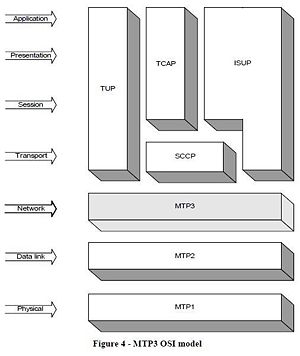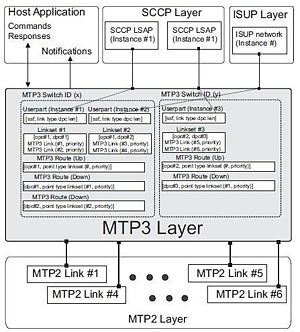MTP3
The MTP3 layer provides message routing between signaling points in an SS7 network. This layer routes traffic away from failed links and signaling points and controls traffic when congestion occurs. The MTP3 layer contains a Userpart that represents a specific protocol variant.
The first graphic on the right shows how MTP3 provides the network layer functionality within the OSI model. A conceptual illustration of TelcoBridges' implementation of the MTP3 layer is provided in the second image on the right.
Using the services of MTP2, the MTP3 layer essentially controls the networking aspect of SS7. This layer knows every reachable destination (represented by a 'point code') within the SS7 network and knows about the path(s) (called 'route(s)') to reach them. A point code can be compared to an address in the IP world. It also knows the state of every destination at any time in addition of knowing the state of every path to them. This last functionality allows this layer to perform re-routing live, without any packet loss, in case of a link failure. This layer is the base of the SS7 redundancy architecture and makes the SS7 network fault-tolerant. This robustness however has a price which is the rigidity of the MTP3 layout. Adding a new node (point-code) to the network needs a reconfiguration of every other node that needs to talk to it. There is no automatic discovery mechanism to do that. Special nodes, called STP, in the SS7 network are designated to act as MTP3 relays to route messages from one SS7 end-node to another. Those nodes are usually deployed in pairs to allow for failure recovery of the network.
Contents |
Features
MTP3 supports the following features:
- Acts as a signaling point or signaling transfer point
- Handles either national or international signaling traffic
- Supports national option with and without multiple congestion priorities
- Supports message discrimination function. If the signaling point is the destination point, the message is delivered to the message distribution function. If the signaling point is not the destination point, and the transfer capability is enabled, the message is delivered to the message routing function
- Supports message distribution function. Delivers a message to the appropriate user part or MTP3 function based on the service indicator.
- Supports message routing function. Selects the appropriate signaling link for the transmission of messages. Performs load sharing between links or linksets
- Uses signaling traffic management procedures to divert signaling traffic from signaling links or signaling routes. Also used to temporarily reduce the quantity of traffic in case of congestion. The following signaling traffic management procedures are supported:
- Changeover
- Changeback
- Forced rerouting
- Controlled rerouting
- Signaling point restart
- Management inhibiting
- Processor outage
NOTE: The signaling point restart is not required for certain country variants, and can be disabled through configuration.
- Uses signaling link management procedures to control the local signaling links. The following basic signaling link management procedures are supported:
- Signaling link activation
- Signaling link restoration
- Signaling link deactivation
- Linkset activation (normal and emergency restart)
- Signaling link congestion
- Signaling link test
- Signal routing test (only for TTC/NTT, Japan)
- Uses signaling route management procedures to ensure a reliable exchange of information between signaling points concerning the availability of signaling routes. The following signaling route management procedures are supported:
- Transfer prohibited
- Transfer cluster prohibited (ANSI/Bellcore)
- Transfer allowed
- Transfer cluster allowed (ANSI/Bellcore)
- Transfer restricted
- Transfer cluster restricted (ANSI/Bellcore)
- Transfer controlled (international and national with congestion priorities)
- Signaling route set test
- Signaling cluster route set test (ANSI/Bellcore)
- Signaling route set congestion test
- Broadcasting of route management messages (such as transfer prohibit and transfer allowed) with multiple point codes (only for TTC/NTT, Japan)
NOTE: Transfer restricted, MTP restart, and route-set-congestion test procedures are national options and can be enabled or disabled through configuration. Supporting multiple congestion priorities is also a national option and can be controlled through configuration. The incoming cluster route management messages (TCP/TCR/TCA/RCP) are handled by MTP3. MTP3 software does not generate cluster management messages and cluster routing.
TelcoBridges and MTP3
TelcoBridges supports multiple MTP3 layer standards and variants in its SS7 signaling stack. It also provides the following functionality:
- Up to 64 Originating Point Codes (OPC) and 512 Destination Point Code (DPC) per unit
- Up to 256 linksets per unit, 512 linksets per system
- Point code sharing with TMG7800 system
See SS7 for more details.

